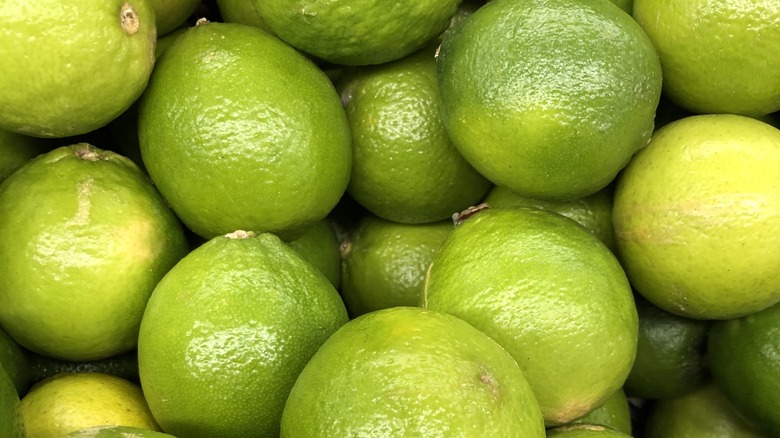Why Drinking A Margarita On The Beach Could Be More Dangerous Than You Think
When you think of beachside dangers, the mind naturally drifts to things like shark attacks and tidal waves. Rarely, however, does one stop to consider that the delicious tropical cocktail in their hand might be more harmful than they initially believed. Unfortunately, there is a particular ingredient found in a refreshing margarita that, when combined with the bright beach sunlight, can lead to potentially harsh skin irritation. But, what exactly is the risk?
Well, it's phytophotodermatitis, if you'll allow us to use a fancy medical term! Also known as the less tough-to-say "margarita burn," this skin condition arises from handling citrus fruits, notably limes, in the UV rays of the sun. Irresistible as it may be to enjoy a refreshing, lime-based drink to beat the seaside heat, it's smart to be aware of the threat of margarita burn when doing so. Lime juice can get everywhere when prepping these drinks, so heed this warning before you go to take that first sip in the sand!
Margarita burn comes from limes
Margarita burn is caused by a chemical in citrus fruit called psoralens. According to RxList, psoralens speed up the process of a sunburn on the skin when combined with UV rays, and can intensify the affected area burn as though it's been in the sun for a half hour, in mere minutes. Though this irritant can also be found in guacamole, chicken marinades, and even celery stalks, most often the culprit is a refreshing lime. Columbia University professor and dermatologist Lindsey Bordone explained to Bon Appétit that the majority of phytophotodermatitis cases are predominantly rooted in handling limes in the sun, and warns that one could get it indoors by cutting limes in the way of a sunny window.
The burn itself is a redness that can often be confused with poison ivy, hives, or most commonly a classic sunburn. Pigmentation lasts about a week to a month and varies from case to case. Bordone says the burns are a bit painful, but fortunately not as severe as other types of burns one may suffer. Furthermore, it's not guaranteed that everyone will get a margarita burn in these conditions, and people who are most likely to be affected tend to already be aware of their skin's sensitivity from predisposed conditions. But, as stated in this 2021 study in The Journal of the American Board of Family Medicine, it is possible to spread even without any pre-existing skin situations, so it's good to be wary.
How to prevent margarita burn
As luck would have it, margarita burn is not dangerous in the long run, which is likely why it isn't very widely known. According to Healthline, most cases are mild enough to be treated with common topical steroid ointments, or even just go away on their own with enough time. To reduce your risk of suffering a bout with the burn, it's recommended to steer clear of citrus to come in contact with your exposed skin if at all possible when in the direct sunlight. So, be sure to handle that cocktail with care, and make sure no errant juice finds its way onto your hand or arm, and your vacation shouldn't be waylaid by a sudden trip to the dermatologist.
There's no stopping the urge to enjoy the perfect margarita in the beating sun, but now that you know the potential risks, be sure to take the proper precautions the next time you do. If at all possible, handle your citrus in a shady spot, or safely indoors, and consider rinsing your hands if any fruit innards get on your skin while in the sun. Plus, there's always the less popular option of wearing protective rubber gloves to the beach, but we unfortunately can't guarantee they'll match your swim trunks.


